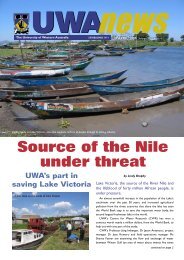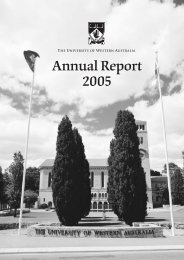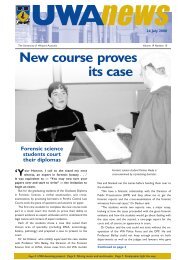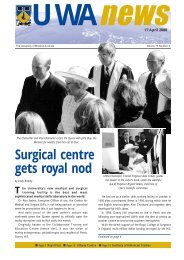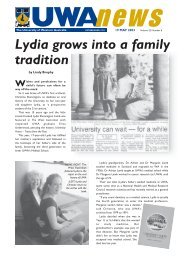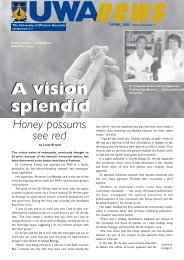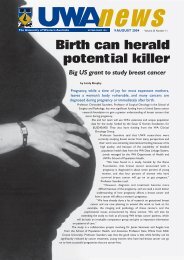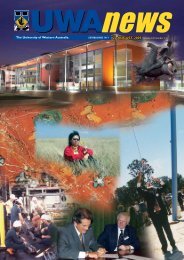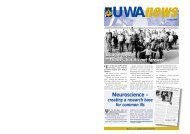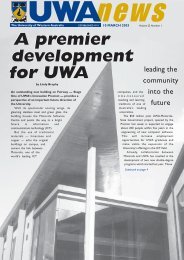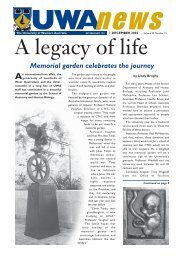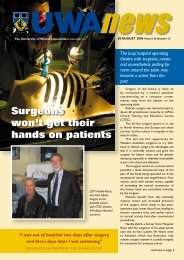Untitled - Annual Report 2004 - The University of Western Australia
Untitled - Annual Report 2004 - The University of Western Australia
Untitled - Annual Report 2004 - The University of Western Australia
Create successful ePaper yourself
Turn your PDF publications into a flip-book with our unique Google optimized e-Paper software.
Statistical Pr<strong>of</strong>ileTHE FOLLOWING tables provide statistics on studentenrolments and completions, and staffing levels.Some <strong>of</strong> the key features are described below.• <strong>The</strong> net enrolment <strong>of</strong> the <strong>University</strong> increased by 26.5 per cent from 1995 to <strong>2004</strong>, with higher degree byresearch enrolments growing by 27.6 per cent and other postgraduate enrolments increasing by 103.2 per centover the same period (Table 1). Postgraduate enrolments represented 24.8 per cent <strong>of</strong> total enrolments in <strong>2004</strong>compared with 19.5 per cent in 1995. Higher degree by research enrolments amounted to 10.5 per cent <strong>of</strong> the totalenrolments in <strong>2004</strong> compared with the same percentage in 1995.• <strong>The</strong> proportion <strong>of</strong> full-time students at the <strong>University</strong> has declined marginally from 1995 to <strong>2004</strong> (Table 2).• Female students comprised 50.1 per cent <strong>of</strong> net enrolments in <strong>2004</strong>, compared with 48.8 per cent in 1995 (Table 2).<strong>The</strong>y accounted for 50.9 per cent <strong>of</strong> higher degree by research enrolments and 43.8 per cent <strong>of</strong> other postgraduateenrolments in <strong>2004</strong> (Table 5).• <strong>The</strong> <strong>University</strong> has been diversifying its sources <strong>of</strong> funding (Tables 3 and 4). While domestic non-fee-paying(i.e. Research Training Scheme and operating grant) load continues to be the major proportion (78.8 per cent <strong>of</strong> thetotal student load), the load <strong>of</strong> domestic fee-paying students increased from 2.7 per cent to 4.4 per cent over the2000–<strong>2004</strong> period and fee-paying international student load increased from 12.0 per cent to 16.5 per cent over thesame period.• Over two-thirds <strong>of</strong> the domestic fee-paying student load was in master’s coursework courses (Table 5).• <strong>The</strong> percentage <strong>of</strong> fee-paying international student load in higher degrees by research was 11.0 per cent as comparedwith an overall average <strong>of</strong> 10.3 per cent. Also, 19.1 per cent <strong>of</strong> fee-paying international student load was in otherpostgraduate courses as compared with an overall average <strong>of</strong> 9.1 per cent (Table 5).• <strong>The</strong> <strong>University</strong>’s student load exceeded the DEST undergraduate operating grant load target by 381 EFTSU (4.2 percent) and the postgraduate coursework operating grant target by 67 EFTSU (44.7 per cent) (Table 6).• Within the <strong>University</strong>, the Faculty <strong>of</strong> Economics and Commerce had the largest student load with 20.0 per cent <strong>of</strong>the <strong>University</strong> total (Tables 7 and 8), however the Faculty <strong>of</strong> Life and Physical Sciences had the largest higherdegree by research load with 21.0 per cent <strong>of</strong> the <strong>University</strong>’s total higher degree research load. <strong>The</strong> Faculty <strong>of</strong>Education had the highest proportion <strong>of</strong> load in higher degrees by research, 31.6 per cent, ahead <strong>of</strong> the Faculty <strong>of</strong>Natural and Agricultural Sciences with 28.9 per cent <strong>of</strong> its load in higher degrees by research.• <strong>The</strong> numbers <strong>of</strong> degrees and awards conferred annually by the <strong>University</strong> has increased from 2889 in 1995 to4089 in <strong>2004</strong>; an increase <strong>of</strong> 41.2 per cent (Table 9).• <strong>The</strong> overall staffing level <strong>of</strong> the <strong>University</strong> has increased by 16.2 per cent from 2000 to <strong>2004</strong> (Table 10). Over thisperiod, the total staff FTE in academic organisational units increased by 14.5 per cent. <strong>The</strong> net increase <strong>of</strong> 256staff FTE in academic organisational units comprised increases <strong>of</strong> 66 FTE teaching-and-research academicstaff, 47 FTE research-only academic staff, 41 FTE research-only non-academic staff and 102 FTE other nonacademicstaff. <strong>The</strong> overall staffing level in non-academic organisational units increased by 21.1 per centover the same period.• Female staff represented 49.7 per cent <strong>of</strong> the total staff FTE (excluding the FTE <strong>of</strong> casual staff) (Table 10).This contrasts with the 45.5 per cent recorded in 2000. However female staff FTE accounted for 64.0per cent <strong>of</strong> the non-academic staffing level in academic organisational units and 57.5 per cent <strong>of</strong> thestaffing level in non-academic organisational units.Further statistics are provided in the Performance Indicators section <strong>of</strong> this <strong>Annual</strong> <strong>Report</strong>.page 33



